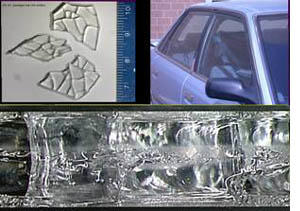
Glass

The same principles of transfer apply to glass as with other types of evidence and can be used to provide significant information for all types of criminal investigations. A glass analyst can determine whether samples of glass could have originated from the same source by observing a variety of physical, optical and elemental properties of the glass. The physical and optical characteristics would be noted using ultra-violet light, stereomicroscopy, and brightfield/polarized light microscopy. The refractive index and density of the glasses will also be determined. A compositional analysis of the glass is also performed to determine and compare the chemical elements present in the glass. A glass analyst can also determine the direction of force used to break a piece of glass by examining the fracture characteristics of a radial crack once the pieces have been reassembled.